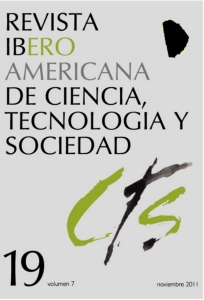El artefacto, ¿estructura intencional o sistema autónomo?
La ontología de la función artefactual a la luz del intencionalismo, el dualismo y la filosofía de Gilbert Simondon
DOI:
https://doi.org/10.52712/issn.1850-0013-740Palavras-chave:
función, estructura, dualismo, SimondonResumo
El presente trabajo aborda un análisis comparativo entre la noción de función, tal como ha sido desarrollada en la filosofía analítica, y la noción de función en la filosofía de Simondon. Se examina la relación entre agencia, intencionalidad, y el uso y producción de artefactos en ambos enfoques. Una característica llamativa es que en la filosofía de Simondon no se establece la distinción entre función y estructura, la cual es central en el dualismo artefactual. Finalmente se examina la noción sistémica de la función desarrollada por Cummins en el lado analítico, la cual se considera complementaria o afín a la de Simondon.
Downloads
Referências
ARTHUR, B. W. (1989): “Competing technologies, increasing returns, and lock-in by historical events”, Economic Journal, 99, pp. 116-31.
ARTHUR, B. W. (2009): The nature of technology: What it is and how it evolves, Washington, The Free Press.
BAKER, L. (2004): “The ontology of artefacts”, Philosophical Explorations, vol. 7, nº 2, pp. 99-111.
BULLER, D. (1998): “Etiological theories of function: A geographical survey”, Biology and Philosophy, 13, pp. 505-527.
CARRARA, M. y VERMAAS, P. (2009): “The fine-grained metaphysics of artefactual and biological functional kinds”, Synthese, 169, pp. 125-143.
CUMMINS, R. (1975): “Functional analysis”, Journal of Philosophy, 72, pp. 741-765.
DAVID, P. (1985): “Clio and the economics of QWERTY”, American Economic Review, 75, pp. 332-37.
DIPERT, R. (1995): “Some issues in the theory of artefacts: Defining ‘artefact’ and related notions”, Monist, 78(2), pp. 119-136.
ELDER, C. (2007): “On the place of artefacts in ontology”, en E. Margolis y S. Laurence (Eds.): Creations of the mind: essays on artefacts and their representation, Oxford, Oxford University Press, pp. 33-51.
HILPINEN, R. (1993): “Authors and artefacts”, Proceedings of the Aristotelian Society, New Series, 93, pp. 155-178.
HOUKES, W., VERMAAS, P., DORSO, K. y DE VRIES, M. J. (2002): “Design and use as plans: an action-theoretical account”, Design Studies, 23, pp. 303-320.
HOUKES, W. y MEIJERS, A. (2006): “The ontology of artefacts: the hard problem”, Studies in History and Philosophy of Science, 37, pp. 118-131.
HOUKES, W. y VERMAAS, P. (2009): “Contemporary engineering and the metaphysics of artefacts: Beyond the artisan model”, The Monist, 92(3), pp. 403-419.
ILLIES, C. y MEIJERS, A. (2009): “Artefacts without agency”, The Monist, 92(3), pp. 420-440.
KROES, P. y MEIJERS, A. (2006): “Introduction: The Dual Nature of Technical Artefacts”, Studies in History and Philosophy of Science, 37, pp. 1-4.
LEWENS, T. (2004): Organisms and artefacts: Design in nature and elsewhere, Cambridge, MIT Press.
MITCHAM, C. (2002): “Do artefacts have dual natures? Two points of commentary on the Delft Project”, Techné, vol. 6, nº 2.
MONTOYA SANTAMARÍA, J. W. (2006): La individuación y la técnica en la obra de Gilbert Simondon, Medellín, Editorial Universidad EAFIT.
MUMFORD, S. (2006): “Function, Structure, Capacity”, Studies in History and Philosophy of Science, 37, pp. 76-80.
PRESTON, B. (1998): “Why is a Wing like a spoon? A pluralist theory of function”, The Journal of Philosophy, vol. 95, nº 5, pp. 215-254.
SEARLE, J. (1995): The construction of social reality, Nueva York, The Free Press.
SIMONDON, G. (2008): El modo de existencia de los objetos técnicos, Buenos Aires, Prometeo.
SIMONDON, G. (2009): La individuación a la luz de las nociones de forma y de información, Buenos Aires, Editorial Cactus & La Cebra.
TENNER, E. (1996): Why things bite back: Technology and the revenge of unintended consequences, Nueva York, Alfred A. Knopf.
THOMASSON, A. (2003): “Realism and human kinds”, Philosophy and Phenomenological Research, vol. 67, nº 3, pp. 580-609.
THOMASSON, A. (2007): “Artefacts and human concepts”, en E. Margolis y S. Laurence (Eds.): Creations of the mind: essays on artefacts and their representation, Oxford, Oxford University Press, pp. 52-73.
TOSCANO, A. (2007): “Technical culture and the limits of interaction: A note on Simondon”, en J. Brouwer y A. Mulder (Eds.): Interact or Die!, Rotterdam, NAi, pp. 198-205
VERMAAS, P. (2009): “On unification: Taking technical functions as objective (and biological functions as subjective)”, en U. Krohs y P. Kroes (Eds.): Functions in biological and artificial worlds: Comparative philosophical perspectives, Cambridge y Londres, MIT Press, pp. 69-87.
VERMAAS, P. y HOUKES, W. (2006): “Technical functions: A drawbridge between the intentional and structural natures of technical artefacts”, Studies in History and Philosophy of Science, 37, pp. 5-18.
WOUTERS, A. (2005): “The function debate in philosophy”, Acta Biotheoretica, 53, pp. 123-151.
Downloads
Publicado
Como Citar
Edição
Seção
Licença
Copyright (c) 2024 CC Attribution 4.0

Este trabalho está licenciado sob uma licença Creative Commons Attribution 4.0 International License.
Todas os números de CTS e seus artigos individuais estão sob uma licença CC-BY.
Desde 2007, a CTS proporciona acesso livre, aberto e gratuito a todos seus conteúdos, incluídos o arquivo completo da edição quadrimestral e os diversos produtos apresentados na plataforma eletrônica. Esta decisão é baseada no entendimento de que fornecer acesso livre aos materiais publicados ajuda a ter uma maior e melhor troca de conhecimentos.
Por sua vez, em se tratando da edição quadrimestral, a revista permite aos repositórios institucionais e temáticos, bem como aos sites pessoais, o autoarquivo dos artigos na versão post-print ou versão editorial, logo após da publicação da versão definitiva de cada número e sob a condição de incorporar ao autoarquivo um link direcionado à fonte original.











